Abstract
A microwave technique was used to prepare a superabsorbent polymer (SAP) by grafting two hydrophilic monomers onto a polysaccharide substrate. The monomers used were acrylic acid (AA) or acrylamide (AM) and were grafted onto a pullulan (PUL) substrate to form PUL-g-AA (SAP1) and PUL-g-AM (SAP2), respectively. The monomers (AM/AA) were grafted together onto a PUL substrate to form PUL-g-(AM/AA) (SAP3). Grafting parameters such as grafting efficiency with the percentage, the conversion of monomer into polymer, gel content, water retention, water adsorption capacity, and swelling kinetics were determined. Additionally, the effect of environmental pH (2, 4, 7, 9, and 12) and sodium dodecylbenzene sulfonate (SDBS) surfactant was evaluated, where 1, 2, 3, 4, and 5 mM of SDBS was added to form SAP4 to SAP8. The FTIR results show that AM was grafted onto PUL through an aliphatic C-N bond, while AA grafting occurred through a single C-C bond. The grafting efficiency with AM was higher than with AA, as well as showing a superior gel content. Water absorbance capacity and water retention increased with the grafting of AA and AM together for SAP3. The highest absorbent capacity, water retention, gel content, and grafting parameters values were obtained with a 3 mM SDBS content and a pH of 7. The swelling kinetics showed that the increases in the theoretical and experimental swelling equilibriums were 72% and 82%, respectively, for SAP6 compared to the values of these parameters for SAP3. The water absorption capacity of the hydrogel increases upon increasing the pH to 7 and then gradually decreases. XRD demonstrated the improved crystallinity and crystalline size of the hydrogel after grafting polymerization of AM/AA onto PUL, in addition to enhanced thermal stability. On the contrary, FE-SEM demonstrated that SDBS improves the porosity and pore size of the hydrogel surface with SAP6.
1. Introduction
Super absorbent polymers (SAPs) contain large hydrophilic networks that allow them to absorb and retain large amounts of water or aqueous solutions, and it is difficult to remove the absorbed water with simple pressure [1]. These polymers have 3D networks that can absorb large amounts of water, up to 300 times their initial mass or more [2]. SAPs may be natural or synthetic depending on where they came from [3,4].
Ideal SAPs have a high swelling capacity, a rapid water absorption capacity, and high reusability [5]. The ability of SAPs to absorb water depends on the hydrogen bonds with water molecules, the ionic concentration of the aqueous solution, and the type of bonds used to make the gel [6]. Polymers with a high absorption ability are SAPs with a low cross-linking density and lead to the formation of a softer gel [7]. Polymers with high-density cross-linked networks are characterized by low absorption and lead to the formation of a gel that is not flexible under the influence of simple pressure [8].
The biodegradability of natural SAPs such as cellulose, starch, and chitosan is a clear benefit. However, they are affected by requiring a high amount of water despite a low absorption rate [9,10]. In contrast, despite the benefits of their low cost, long service life, and high water absorption rate, the non-degradable characteristics of synthetic SAPs such as poly acrylic acid (PAA) and polyacrylamide (PAM) can have negative effects on the environment and plant growth [11,12]. There are many methods to improve the efficacy of SAPs, improve their hydrophilicity, and develop specialized network architectures, such as interpenetrating polymer networks (IPNs), semi-interpenetrating polymer networks (semi-IPNs), and copolymer networks [13]. Among the many uses of SAP, they are used to manage the release of nutrients and to improve the efficiency with which soil uses water [5]. Therefore, the establishment of a porous structure is the key to enhancing swelling rate and regulating their properties [8,14]. Currently, there are several technologies for the fabrication of porous hydrogels, including freeze-drying [15], foaming [16], water-soluble porogens [17], and the phase inversion technique [18].
Therefore, most of the above techniques are characterized by producing hydrogels with a large pore size distribution and closed pores [19,20]. Grafting polymerization is one important method for the chemical modification of polymers’ specifications. Grafting methods include the use of microwave radiation, plasma, ozone, and photometry [21]. Polymerization is a method to determine the physical and chemical properties of a polymer by polymerizing its surfaces using grafting methods, with good behavior of the polymers resulting after modifying their surfaces using graft polymerization [22]. Polysaccharides such as starch, cellulose, and chitin are polysaccharides that contain biomolecules including long-chain carbohydrates and several smaller monosaccharides [23].
Pullulan is a natural water-soluble polysaccharide with repeating units of malt triose residues extracted from the yeast-like fungus Aureobasidium [24,25]. Due to its significant role in reducing ionic surface tension, sodium dodecylbenzene sulfonate (SDBS) is widely used in household detergents [26]. In addition, SDBS increases hydrogels’ surface porosity and swelling kinetics according to its concentration in superabsorbent polymers [27]. Microwave irradiation is frequently used in polymerization grafting reactions, especially when many monomers are grafted onto natural polymers, such as grafting acrylonitrile monomers onto guar gum, acrylamide onto chitosan, and methyl methacrylate onto bamboo cellulose [28], in addition to the use of microwave radiation in the development of cross-linking in hydrogels, which does not require a catalyst [29], instead using high-frequency electromagnetic waves [30]. Microwave irradiation has the advantages of a low reaction time, an increased production capacity, and high reaction control in terms of producing few by-products and being environmentally friendly [31]. Microwaves can provide the energy necessary to encourage the initiator to enter the reaction by overcoming the energies of some of its bonds, breaking them and forming free radicals, which represent active sites for starting the reaction [32].
This research aims to prepare super absorbent polymers (SAPs) using grafting polymerization (microwave irradiation) of acrylic acid and acrylamide monomers based on pullulan as the substrate and then compare the effects of SDBS surfactant and environmental pH from the viewpoint of their swelling parameters.
2. The Experimental Section
2.1. Materials and Methods
Pullulan (PUL) is used as a polysaccharide substrate, while acrylamide (AM) and acrylic acid (AA) monomers are used for grafting purposes. Sodium dodecylbenzene sulfonate (SDBS) (MW = 348 g/mol) is a surfactant. The chemicals needed to complete the research were purchased from Merck and used without further purification for the following purposes: potassium persulfate (KPS) was used as the initiator in an inorganic chemical reaction, and N, N-methylene bisacrylamide (MBA) was used to form cross-links. N, N-, N-tetramethylene diamine (TEMED) was used as an accelerator for the polymerization reactions, while sodium hydroxide (NaOH) and solvents such as distaste water (DW), methanol, and ethanol were used for acid neutralization and washing, respectively.
2.2. Preparation and Absorption Measurement of SAPs
2.2.1. Preparation of SAPs
Superabsorbent polymers (SAPs) were made by grafting monomers (AM/AA) onto PUL according to the following steps:
- Mixing monomers step: The AA and AM monomer solutions were mixed, and MBA solution was added (0.04 g in 5 mL of DW). The AM monomer solution was prepared by dissolving 6 g in 12 mL of DW with continuous stirring. The AA solution was prepared in an ice bath to avoid polymerization by dissolving 6 g of AA monomer with partial neutralization (80% by weight) using 5 M NaOH.
- Substrate preparation step: The pullulan substrate concentration was prepared by dissolving 1.20 g of PUL in 35 mL of distilled water, at about 3.2 wt.%. The solution was mixed by a mechanical mixer at 60 °C for 15 min, and then aqueous solutions of SDBS surfactants at different concentrations (0, 1, 2, 3, and 4 mM) were continuously mixed until a homogeneous solution was obtained.
- Generation of free radicals: To facilitate the grafting step, free radicals were generated using a redox initiator system composed of two solutions: 0.118 g of KPS and 0.051 g of TEMED (each in 5 mL of DW). These solutions were added dropwise to the PUL solution at a temperature of 60 °C for 10 min in the presence of strong mechanical mixing.
- Grafting step: The monomer solution (AM/AA) was added to the PUL solution after it was cooled to 50 °C, with mechanical mixing at a rotational speed of 1050 rpm for 15 min. The final solution of the reaction mixture was supplemented with 100 mL of added DW, and the final solution was treated in a microwave oven at 475 watts for 4 min. The temperature and viscosity of the mixture gradually increased, and the gelation point was reached after 250 s; the product was a yellowish elastic gel. The SAP grafting polymerization reactions are explained in Figure 1.
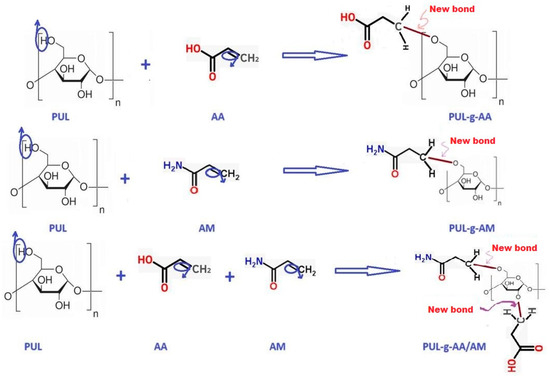 Figure 1. Grafting polymerization reactions of SAP1, SAP2, and SAP3 using potassium persulfate (KPS) as an initiator.
Figure 1. Grafting polymerization reactions of SAP1, SAP2, and SAP3 using potassium persulfate (KPS) as an initiator. - Treatment of the final product: To remove the remaining surfactant, the resulting elastic gel was cut into small pieces, and the resulting gel was washed several times with ethanol/water (10:1, v/v). Then, the unreacted materials (PUL, AA, AM, KPS, TEMED, and MBA) were completely removed after immersion in pure methanol for 24 h to dehydrate and dissolve without reacting. The final product was washed with ethanol and then ground and baked in an oven at 60 °C for 24 h [27,33].
2.2.2. Swelling Measurements
The water absorbency of the hydrogels is measured using the free swelling method and is calculated in grams of water per 1 g of the hydrogel. Thus, an accurately weighed quantity of the polymer under investigation (0.1 g) is immersed in 500 mL of distilled water at room temperature for at least 4 h. Then, the swollen sample is filtered through a weighed 100-mesh (150 µm) sieve until water ceases to drop. The weight of the hydrogel containing absorbed water is measured after draining, and the water absorbency is calculated according to the following equation [34,35]:
where is the water absorbence capacity, and (, ) are the weights of the swollen specimen and the dry specimen before washing, respectively. The swelling kinetics was studied at different concentrations of SDBS (0, 1, 2, 3, and 4 mM) for several consecutive periods (1800, 3600, 5400, 7200, 9000, 10,800, 12,600, and 14,400 s). In addition, the effects of pH on swelling capacity were measured for aqueous solutions of various pH values (2, 4, 7, 9, and 12) at room temperature.
2.2.3. Measurement of Grafting Parameters
Gel Content: To measure the gel content, accurately weighed dried samples of the SAPs are dispersed in distilled water to swell completely. Then, the swollen SAPs are filtered and washed with distilled water frequently. The samples are dewatered in excess ethanol for 48 h and dried at 50 C for 12 h until the SAPs have a constant weight. The gel content is defined as the following equation [36]:
where and are the weight of the dried hydrogel after extraction and the initial weight of the SAP, respectively.
Grafting Polymerization: The weight percentage of the synthetic polymer branches grafted onto the functional groups of the pullulan to the total synthetic polymer, including grafted branches and undrafted photopolymers, is calculated. Grafting percentage (G (%)), grafting efficiency (), and the conversion of monomers into polymers (C (%)) are determined by the following relations [37]:
where W0, W1, W2, and W3 denote the weight of the pullulan, the final weight of the grafted hydrogel after production, the weight of the monomers, and the mass of monomers in the grafted polymer.
Water retention: The pre-weighed swollen gels () equilibrated in distilled water were kept at room temperature for 24 h. Then, the mass of the hydrogels was recorded and marked as . The water retention is calculated according to the following relationship [38]:
Surface area measurements (BET): The specific surface area and micropore volume of the composites and components were determined according to the physical adsorption of nitrogen with the BET method at a temperature of 77 K using a Micromeritics ASAP 2400 automatic analyzer (Norcross, GA, USA). The average size and size distribution of the composites and components were determined by screen analysis performed by using Tyler standard sieves (Quantachrome Instruments, Boynton Beach, FL, USA).
2.3. Characterization
FTIR tests was carried out to identify the chemical structure of the PUL, AA, and AM, where IR spectra recorded in the range of 400–4000 cm−1 were recorded. This technique was also used to identify the model grafting (if existent) of these components.
With the XRD technique (D8 Bruker, Berlin, Germany), data were collected at 0.02-degree intervals with a count of 0.5 s per step in the 2° range of 10–80°. This test was conducted to monitor the effects of the surfactant concentrations on the crystallite size and crystallinity percentage. The DSC-TGA technique (SDT Q600 V20.9 Build 20) was used to study thermal transitions and thermal stability. On the other hand, the morphological properties of the samples’ surfaces were studied using the FE-SEM technique (ZEISS Sigma, Jena, Germany).
3. Results and Discussions
3.1. Prepared SAPs
A group of SAPs based on PUL was prepared according to the composition details mentioned in Table 1, such as (SAP1): PUL-g-AA; (SAP2): PUL-g-AM; (SAP3): PUL-g-AM/AA; and (SAP6): PUL-g-AM/AA-3 mM SDBS, respectively.

Table 1.
Composition of samples of the prepared SAPs.
Figure 2A shows the FE-SEM images of various SAPs, with weak bonds between the SAP1 and SAP2 gel particles. The supramolecular nature of bonding of the superabsorbent polymers as they were prepared in this work involved a three-dimensional network connecting the gel particles at SAP3 and SAP6 and the formation of pores due to the interlocking structures of the hydrogels shown in the PUL-g-AM/AA structure. In addition, hydrogels are a broad class of hydrophilic materials formed by three-dimensional networks held together by covalent bond cross-links and weak cohesive forces in the form of hydrogen or ionic bonds. These cross-linked macromolecular structures can absorb large quantities of water and biological fluids without dissolution [39]. On the other hand, the advantage of the strength of the association between complementary hydrogen bonding units is that it affords stable supramolecular materials. The properties of these new materials were comparable to linear polymers possessing molecular weights far greater than the self-associating oligomeric units involved in supramolecular network formation. Molecular recognition units have been incorporated within macromolecular structures in several different ways to afford supramolecular networks, for example, at polymer chain ends [40], the termini of the arms of combs/brushes [41], or within the polymer main chain. In addition, the polymer architecture and the number of molecular recognition units per polymer chain (referred to as valency [42]) have also been adjusted to afford stable and processable supramolecular materials to permit multiple sites of association per polymer chain.
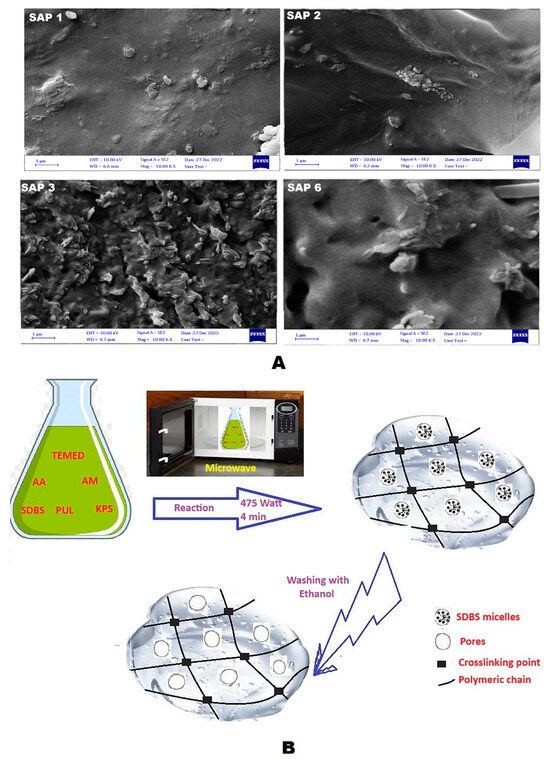
Figure 2.
(A) FE-SEM images (1 µm) for SAP1, SAP2, SAP3, and SAP6, respectively; (B) schematic of the formation of the SDBS micelle template during the reaction and after washing with ethanol.
The SDBS surfactant altered the compact structure of PUL-g-AM/AA into a rough surface with deep pores on the hydrogel surface, which means that SDBS acts as a pore-forming agent; these pores became clearer after washing the hydrogel with ethanol (Figure 2B). This is due to the self-assembly of the SDBS particles in the reaction medium. Microwaves provide the energy needed to activate the initiator (KPS) to generate free radicals and accelerate the polymerization reaction using the TEMED. The radicals start the grafting reaction in vinyl monomers such as AA and AM in the double bond of C=C and then propagate to the polymeric chain [43]. The results of FE-SEM coincide with the proposed models; as the graft increased (such as in SAP3), the surface became rougher and more porous, which made it capable of the absorption of more water.
The FE-SEM, as shown in Figure 2, determined the morphological properties of the hydrogels, such as pore volume (nm3) and porosity (%), which were measured by ImageJ software (version 1.54). The porosity of the hydrogels can be calculated by comparing the average pore volume with the volume in the FE-SEM image using the following equation [44]:
where Vp and are the pore volume and the total SEM volume, according to Equation (7), and the porosity % increases with an increase in the pore volume of the hydrogel. The percentage of the increment in the pore volume was 263.78% after adding 3 mM of SDBS to the PUL-g-AM/AA; the results on the pore volume (µm3) and porosity % of the SAPs are shown in Table 2. The pore volume of the hydrogel increased with SDBS compared to the pore volume of the hydrogel that did not contain SDBS [45].

Table 2.
Results of pore volume (µm3) and porosity % of SAPs produced by ImageJ software for SEM images and pore volume (µm3/g) and surface area (m2/g).
Surface area measurements (BET):
The results on the adsorption surface area and pore volume measurements are provided in Table 2. The surface area and the pore volume of SAP6 were significantly different from those of SAP1, SAP2, and SAP3, which had a wider BET surface area. The specific surface area of SAP6 and SAP3 was found to be 3.8 m2/g and 2.19 m2/g, respectively. It can be concluded that SDBS can form spherical micelles when using a certain concentration of the surfactant. In the process of grafting copolymerization and cross-linking, these micelles may be enclosed in the network and act as a template for pore formation [27].
3.2. FTIR Analysis
FTIR spectroscopy was used to specify each component’s chemical composition and determine whether these components chemically reacted. Figure 3 shows the FTIR spectra of PUL, PUL-g-AA, PUL-g-AM, and PUL-g-AM/AA before washing and PUL-g-AM/AA after washing. For the PUL spectrum (Figure 3A), the bands from 738 to 933 cm−1 belong to α-(1, 4) and α-(1, 6)-D-glucosidic bonds. The bands at 1148 cm−1 and 1373 cm−1 are due to C-O-C and C-O-H, respectively, while band 1636 cm−1 is due to the stretching vibration of the O-C-O group. The band at 2924 cm−1 is due to SP3 of the C-H bond, while an O-H stretching vibration occurred from 3217 cm−1 to 3420 cm−1 [46]. For the acrylic acid spectrum (Figure 3B), the band at 3417 cm−1 belongs to the O-H stretching vibration mode. The band at 2924 cm−1 is due to the stretching vibration of CH in the methylene group. A carbonyl group (C=O) appeared at 1634 cm−1, and the bending vibration of the CH2 group occurred at 1440 cm−1. Bending of the O-H group happened at 1381 cm−1, while C-C stretching occurred at 1161 cm−1 and C-OH stretching at 1026 cm−1; the out-of-plane vibration mode for =CH and =CH2 occurred at 871 cm−1 and 810 cm−1, respectively [43].
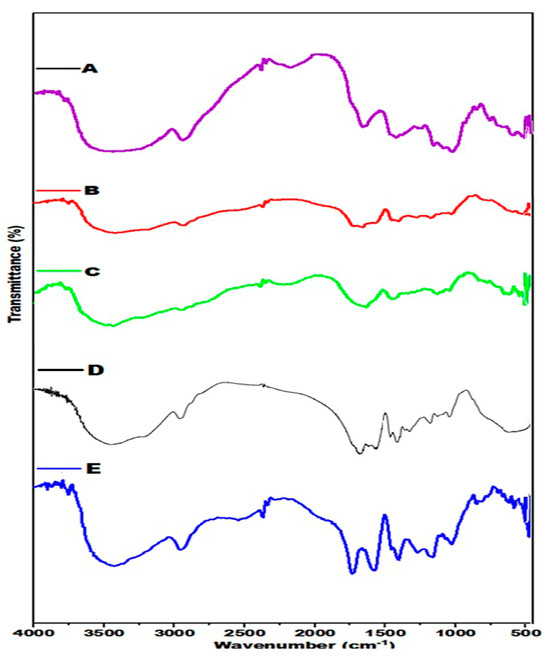
Figure 3.
FTIR analysis of (A) PUL, (B) PUL-g-AA, (C) PUL-g-AM, and (D) PUL-g-AM/AA before washing and (E) PUL-g-AM/AA after washing. For the acrylamide spectrum (Figure 3C), bands from 3240 cm−1 to 3418 cm−1 belong to the symmetrical and asymmetrical stretching vibrations of the N-H group. In contrast, the band at 2932 cm−1 belongs to the stretching vibration of the methylene (CH2) group. The bending vibration of the N-H group appears at 1582 cm−1, while the symmetrical stretching vibration of the carbonyl group (C=O) appears at 1620 cm−1.
At 1404 cm−1, bending vibration of the CH2 group occurred, while out-of-plane bending of =CH and –CH2 occurred at 779 cm−1 and 849 cm−1, respectively [47]. For the spectrum in Figure 3D, the absorption bands at 738 and 933 cm−1 of the PUL spectrum disappeared. At the same time, bands at 1148 and 1636 cm−1 appear, assigned to –COC- stretching of acrylate groups and O-C-O stretching of acrylamide groups, respectively, which suggests the grafting reaction of the copolymer onto the backbone [29]. It is clear from Figure 3E that all three components are present in the structure of the polymeric blend after washing it with ethanol/water and removing unreacted materials. The appearance of bands at about 1600–1700 cm−1 indicates AA grafting, where AA contains a carboxyl group (COOH) [43]. This group includes the OH and C=O groups, which usually appear at these positions. AM grafting is evident at the bands at about 1000–1250 cm−1, and PUL substrate is evident at bands at about 3000–3600 cm−1 and 450–750 cm−1, respectively.
The AM was grafted onto the PUL substrate through an aliphatic C-N bond, with its band appearing at 1000–1250 cm−1. In contrast, AA grafting occurred through a single C-C bond, but since this bond is nonpolar (no difference in electronegativity), it usually does not show up as peaks in an IR spectrum. A covalent bond consists of two electrons from each of two carbon atoms. It is called a sigma bond (σ) between one orbital of each carbon atom.
By comparing the FTIR spectra of the non-washed hydrogel (Figure 3D) and the washed hydrogel (Figure 3E), the typical peak appearing at around 3700–4000 cm−1 is not clear due to the presence of non-reactive materials (such as PUL, AA, AM, KPS, TEMED, and MBA). Meanwhile, it is clearer in Figure 3E, such that the absorption peaks at about 3850 cm−1 can be assigned to O–H stretching vibration. On the other hand, the absorption peaks at 2932 cm−1 can be ascribed to C-H stretching, and the bending vibration is very clear.
3.3. XRD Analysis
The X-ray diffraction patterns of SAP1, SAP2, SAP3, and SAP6 with a range of 10–80° and the results on the crystalline properties are shown in Figure 4 and Table 3. The broad peaks of all the samples with 2 = 18.775–21.94°. The grafting reaction between the PUL, PAA, and PAM monomers changes the crystal structure. The percentage of crystallinity and the crystal size obtained indicate a final structure between the values of the two monomers in the two perpendicular planes of the Miller indices (h k l) (110), according to d-d-spacing of 3.569 and 4.115 for SAP1 and SAP2. However, the orthogonal planes of the structure change to (220) with a spacing of 2.378 Å when grafting the two monomers AM/AA onto the PUL substrate at 2θ = 49.825, also changing the orthogonal planes of the Miller indices (h k l) to (211) after adding SDBS to the hydrogel reaction. Generally, PUL-g-AM/AA with and without SDBS has a partially crystalline hydrogel structure due to the formation of intramolecular hydrogen bonds between the polymer chains in the internal hydrogen structure [27,48,49].
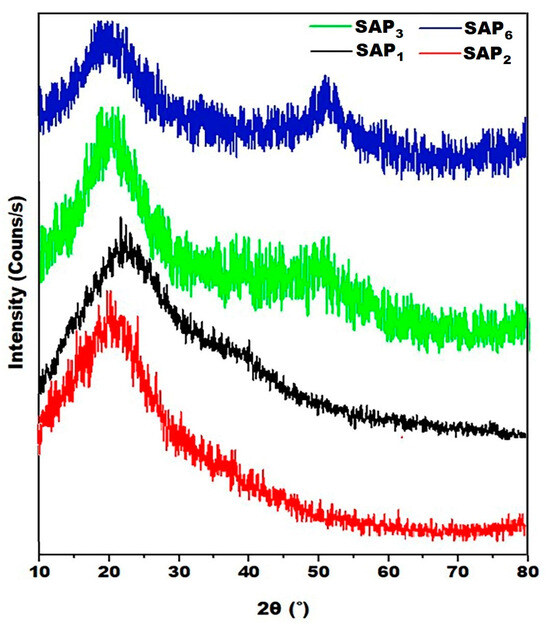
Figure 4.
XRD patterns of SAP1, SAP2, SAP3, and SAP6, respectively.

Table 3.
Crystallinity percent and average crystalline size of some prepared SAPs.
3.4. Thermal Properties
Figure 5 shows the DSC curve (red) and the TGA curve (black) for the prepared SAPs, while Table 4 summarizes the weight loss steps for samples heated up to 800 °C. The results showed that the thermal stability of SAP1 is better than that of SAP2, as it is almost uniform, while in the SAP2 sample, it is irregular, and the sample loses 57.76% of its weight at 300 °C. On the other hand, grafting AA and AM each onto PUL enhances the resistance to thermal decomposition. However, the addition of SDBS works strongly to enhance the thermal behavior of the SAP6 sample, as there is no loss of weight in the sample at 220 °C compared to all the samples, and the thermal decomposition is uniform according to the weight loss steps compared to the SAP3 sample, which lost almost half of its weight at 370 °C. In terms of the influence of the SDBS surfactant on the thermal stability and thermal transitions of PUL-g-AM/AA, the weight loss up to 800 °C was 86.46% (SAP3), while this loss decreased to 72.59% for a sample with 3 wt. % SDBS (SAP6) at 800 °C. It was also noted that weight loss occurred gradually and less severely than in the SDBS-free sample. This indicates that SDBS enhances the stability of the hydrogel [50]. Generally, the first step for the SAPs represented the elimination of the adsorbed free water, and the second step represented the dehydration of the saccharide rings and depolymerization, with the formation of water, CO2, and CH4 [51].
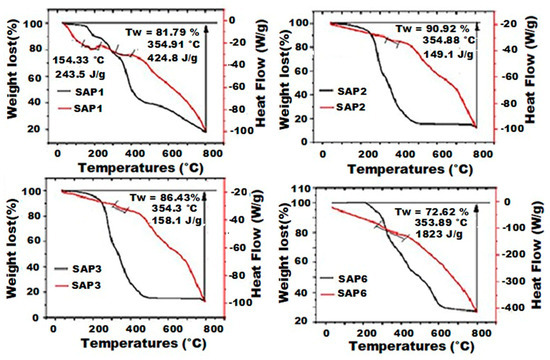
Figure 5.
DSC-TGA curves for SAP1, SAP2, SAP3, and SAP6, respectively.

Table 4.
Weight loss results of SAP samples according to many degradation steps.
This is because SDBS, during polymerization, promotes the emulsification of droplets of the AA and AM monomers, resulting in the solubilization of these two monomers within the micelles and increasing the number of nucleated particles [52]. This behavior is expected to increase the degree of crystallinity. The same finding can be concluded from the DSC curve, where the enthalpy of the thermal transition increased from 158.1 J/g in SAP1 to 1823 J/g in SAP6.The previous results coincide with the increase in crystallinity (%) and crystallite size obtained in the XRD test.
3.5. The Effect of SDBS on the Absorption and Grafting Parameters
For the prepared samples, many absorption and grafting parameters were calculated, such as water retention (WR), gel content (Gel), percentage of grafting (G), grafting efficiency (E), and water absorption capacity (WAC), as shown in Table 5.

Table 5.
Absorbance and grafting parameters for the prepared samples at room temperature and a pH of 7.
The effects of the SDBS concentrations on these properties have a considerable dependence on the concentration of the surfactant in the samples (SAP3 to SAP8) compared to the variation in these parameters without SDBS and when the grafting used only the AA or AM monomers on PUL (SAP1 and SAP2) [43], indicating that micelle creation encourages both swelling and grafting processes. It can be noted that the percentage of water retention in the presence of SDBS increases to 60%, compared to 20% for the hydrogel without SDBS. Furthermore, Gel (%), G (%), and E (%) are the highest for SAP6 (PUL-g-AM/AA-3 mM SDBS). This means that there is an optimal concentration of the surfactant. Beyond this point, the pore-forming ability of SDBS becomes invalid [27,53]. These results agreed with the results of a previous study [27].
3.6. The Effect of SDBS on the Absorption Capacity and Swelling Kinetics
Research studies have shown that hydrogel porosity plays an important role in increasing water absorption, and this property has increased the agricultural applications for this type of polymer [54]. Based on the morphological properties, which were confirmed by the FE-SEM images and the results for the adsorption parameters (water absorbing capacity), Figure 6 shows the increase in the amount of water absorbed with an increase in the absorption time to reach the equilibrium limit as a function of the concentration of SDBS. Reaching the equilibrium state means that expansion either due to penetration through osmotic pressure by the solvent or contraction led to a decrease in enthalpy and the formation of the elastic strength of the network [55]. For each kinetic curve, we can distinguish two sections, an initial rapid increase and the stabilized equilibrium absorbency (Seq), with a rate correction factor R2 ≥ 0.99, indicating the precision of the results. The asymptotic value Seq is dependent on the concentrations of SDBS. The BoxLucas1 model equation is used for non-linear regression in Figure 6 [56]:
where (a) is Seq (g.g−1), y is WAC (g.g−1), x is absorption time (Sec), and b is the slope of the fitting equation.
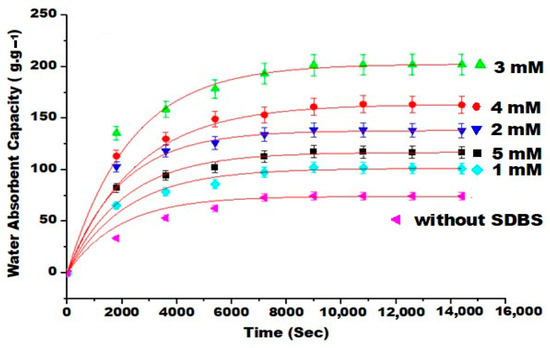
Figure 6.
Time-dependent water absorption capacity curves of SAPs generated by different concentrations of SDBS in distilled water at a pH of 7.
The hydrogels’ sorption properties have been evaluated in terms of the swelling ratio , defined as follows [57]:
Schott’s second-order swelling kinetics model was proposed for studying the absorption kinetics. The relation between the average swelling rate () and swelling time () gives straight lines according to the proposed model [58]:
where is the swelling ratio at time ; is the theoretical equilibrium swelling ratio, which is the reciprocal of slopes of these lines; and is the initial swelling rate constant, which is equal to the reciprocal of the intercept of the fitted straight lines with the Y axis.
Table 6 shows the effect of the surfactant concentrations on swelling parameters such as with at each SDBS concentration and pH value. The results showed that high values for the theoretical equilibrium swelling ratio () with stabilized equilibrium absorbency were obtained with a 3 mM SDBS content and at a pH of 7. As a result, the hydrogel structure was more porous, and the larger the specific surface area, the faster the water diffusion into this structure was. Hydrogel porosity is one of the most important factors affecting the absorption of these polymers [14].

Table 6.
Schott’s pseudo-second-order swelling kinetics model results using different SDBS concentrations on SAPs with a pH of 7 and different pH values with 3 mM SDBS only.
The theoretical values of the equilibrium swelling ratio values are consistent with the stabilized equilibrium absorption for the SDBS concentration and pH values. The initial swelling rate constant values change as the SDBS concentration changes, and the highest value was seen at a 3 mM concentration, in addition to the rate correction factor R2 > 0.98 as an effect of the SDBS concentrations, indicating the precision of the results.
3.7. The Impact of pH on Water Absorbency and Swelling Kinetics
After selecting SAP6 as the best SAP to absorb distilled water at a pH of 7, the water absorption capacity of SAP6 was tested at different pH values (2, 4, 9, and 12) at room temperature (Figure 7) and using different absorption time periods (Figure 8). The results showed that the water absorption capacity of the hydrogel increased with an increasing pH up to 7 and then gradually decreased due to the forces of electrostatic repulsion and hydrogen bonding being in equilibrium [50]. The hydrogel’s ability to swell or absorb water is low when the pH levels are low due to the strong hydrogen bonding, and the presence of -COOH and NH2 groups enhances the physical cross-linking, in addition to neutralizing the electrostatic repulsion between the -COO- groups; therefore, the prepared SAP network tends to shrink. Within the pH range of 4 to 8, ionization of some of the carboxylic acid groups occurs, as does electrostatic repulsion between the -COO groups, leading to increased swelling of the hydrogel [59].
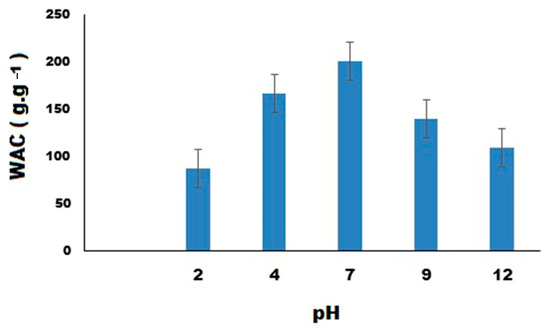
Figure 7.
Effect of environmental pH on water absorbency using 3 mM of SDBS (SAP6).
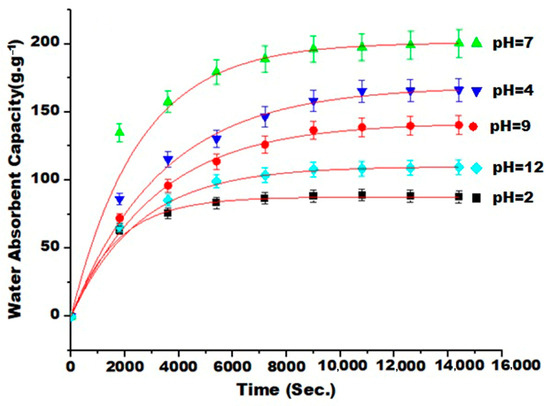
Figure 8.
Relation between water absorbency and swelling time for different pH values using 3 mM SDBS (SAP6).
When the pH value is high, the hydrogel’s swelling ability is low because it is affected by excess sodium ion charges, which protect the carboxylic anions and prevent the formation of active anion–anion repulsion. The water absorbance capacity increases with increasing pH values until a pH of 7 and then decreases. In addition, the water absorption capacity increases with an increasing immersion time in water until it reaches an equilibrium state for all pH values. Table 6 shows swelling kinetics parameters such as and , representing a tendency for the pH value to affect the water absorbed by the hydrogel; these parameters increase with an increasing pH up to 7 and then decrease gradually. The theoretical equilibrium swelling () is consistent with the experimental equilibrium swelling () for all the pH values, seeing increments of 133.87% and 130% at a pH of 7 compared with the values of these parameters at a pH of 2. Also, the change in the initial swelling rate constant () is similar to that of the theoretical equilibrium swelling constant and the experimental equilibrium swelling as a function of pH; these results agree with previous studies [60,61]. The rate correction factor is R2 ≥ 0.99 for the effect of the pH values, indicating the precision of the results.
4. Conclusions
In this work, several superabsorbent polymers (SAPs) were prepared using PUL as the substrate and implementing grafting polymerization of AA and AM monomers, which was carried out in the presence of a redox pair initiator consisting of KPS/TEMED and MBA using microwave irradiation. The FTIR analysis demonstrated that AM/AA grafted onto PUL’s macromolecular chains has higher cross-linking than that of PUL-g-AA or PUL-g-AM. The FE-SEM images confirmed that SDBS improves the surface porosity of the hydrogel, which enhances the ability of the hydrogel to absorb large amounts of distilled water. In addition, SDBS improved the grafting parameters and swelling kinetics parameters. A 3 MM concentration was the best concentration of SDBS, as it had the highest theoretical equilibrium swelling and experimental equilibrium swelling as a function of SDBS and environmental pH.
Author Contributions
S.A.H.: Conceptualization, Methodology, Software, Data Curation, Writing—Original Draft Preparation; A.J.B.: Visualization, Investigation, and Supervision; S.A.D.: Software, Validation, Writing—Reviewing and Editing. All authors have read and agreed to the published version of the manuscript.
Funding
This research received no external funding.
Data Availability Statement
The data presented in this study are available on request from the corresponding author.
Acknowledgments
The authors express their sincere thanks and gratitude to everyone who helped complete this work, especially the employees in the department’s laboratories, CAK Company, and Ali Hussain.
Conflicts of Interest
The authors declare no conflict of interest.
References
- Salih, S.I.; Hashem, F.A.; Braihi, A.J. Preparation and characterization of concrete reinforced by the super-absorbent hydrogel nanocomposites (SAHNCs) used for construction applications. Adv. Nat. Appl. Sci. 2016, 10, 112–125. [Google Scholar]
- Arredondo, R.; Yuan, Z.; Sosa, D.; Johnson, A.; Beims, R.F.; Li, H.; Xu, C.C. Performance of a novel, eco-friendly, cellulose-based superabsorbent polymer (Cellulo-SAP): Absorbency, stability, reusability, and biodegradability. Can. J. Chem. Eng. 2023, 101, 762–1771. [Google Scholar] [CrossRef]
- Braihi, A.J.; Salih, S.I.; Hashem, F.A.; Ahmed, J.A. Proposed cross-linking model for carboxymethyl cellulose/starch superabsorbent polymer blend. Int. J. Mater. Sci. Eng. 2014, 3, 363–369. [Google Scholar] [CrossRef]
- Wei, J.; Yang, H.; Cao, H.; Tan, T. Using poly aspartic acid hydro-gel as water retaining agent and its effect on plants under drought stress. Saudi J. Biol. Sci. 2016, 23, 654–659. [Google Scholar] [CrossRef] [PubMed]
- Tubert, E.; Vitali, V.A.; Alvarez, M.S.; Tubert, F.A.; Baroli, I. Amodeo, Synthesis and evaluation of a superabsorbent-fertilizer composite for maximizing the nutrient and water use efficiency in forestry plantations. J. Environ. Manag. 2018, 210, 239–254. [Google Scholar] [CrossRef] [PubMed]
- Inobeme, A.; Ajai, A.I.; Inobeme, J.; Adetunji, C.O.; Obar, A.; Mathew, J.T.; Nwakife, N. Superabsorbent Polymers for the Development of Nanofiltration. In Properties and Applications of Superabsorbent Polymers: Smart Applications with Smart Polymers; Springer Nature: Singapore, 2023; pp. 157–170. [Google Scholar]
- Rather, R.A.; Bhat, M.A.; Shalla, A.H. An insight into Synthetic, Physiological aspect of Superabsorbent Hydrogels based on Carbohydrate type polymers for various Applications: A Review. Carbohydr. Polym. Technol. Appl. 2022, 3, 100202. [Google Scholar] [CrossRef]
- Shi, X.; Wang, W.; Wang, A. Effect of surfactant on porosity and swelling behaviors of guar gum-poly(sodium acrylate-co-styrene)/attapulgite superabsorbent hydrogels. Colloids Surf. B 2011, 88, 279–286. [Google Scholar] [CrossRef] [PubMed]
- Mistry, P.A.; Konar, M.N.; Latha, S.; Chadha, U.; Bhardwaj, P.; Eticha, T.K. Chitosan Superabsorbent Biopolymers in Sanitary and Hygiene Applications. Int. J. Polym. Sci. 2023, 2023, 4717905. [Google Scholar] [CrossRef]
- Faris, D.; Hadi, N.J.; Habeeb, S.A. Effect of rheological properties of (Poly vinyl alcohol/Dextrin/Naproxen) emulsion on the performance of drug encapsulated nanofibers. Mater. Today Proc. 2021, 42, 2725–2732. [Google Scholar] [CrossRef]
- Singh, J.; Kumar, A.; Dhaliwal, A.S. Superabsorbent Polymers Application in Agriculture Sector. In Properties and Applications of Superabsorbent Polymers: Smart Applications with Smart Polymers, 1st ed.; Springer: Berlin/Heidelberg, Germany, 2023. [Google Scholar]
- Sankar, P.R. Superabsorbent Polymer Sponges for the Design of Saliva Absorption Pad. Ph.D. Thesis, Sree Chitra Tirunal Institute for Medical Sciences & Technology, Kerala, India, 2021. [Google Scholar]
- Villa, A.J.C. Novel Superabsorbent Materials Obtained from Plant Proteins; Swedish University of Agricultural Sciences: Uppsala, Sweden, 2017. [Google Scholar]
- Shi, X.; Wang, W.; Wang, A. pH-responsive sodium alginate-based super porous hydrogel generated by an anionic surfactant micelle templating. Carbohydr. Polym. 2013, 94, 449–455. [Google Scholar] [CrossRef] [PubMed]
- Poursamara, S.A.; Azamib, M.; Mozafari, M. Controllable synthesis and characterization of porous polyvinyl alcohol/hydroxyapatite nanocomposite scaffolds via an in situ colloidal technique. Colloids Surf. B Biointerfaces 2011, 84, 310–316. [Google Scholar] [CrossRef] [PubMed]
- Park, H.; Kim, D. Swelling and mechanical properties of glycol chitosan/poly (vinyl alcohol) IPN-type super porous hydrogels. J. Boimed. Mater. Res. Part A 2006, 78, 662–667. [Google Scholar] [CrossRef] [PubMed]
- Delaney, J.T.; Liberski, A.R.; Perelaer, J.; Schubert, U.S. Reactive inkjet printing of calcium alginate hydrogel porogen—A new strategy to open-pore structure matrices with controlled geometry. Soft Matter 2010, 6, 866–869. [Google Scholar] [CrossRef]
- Elbert, D.L. Liquid-liquid two-phase systems for the production of porous hydrogels and hydrogel microspheres for biomedical application: A tutorial review. Acta Biomater. 2011, 7, 31–56. [Google Scholar] [CrossRef] [PubMed]
- Partrap, S.; Muthutantri, A.; Rehman, I.U.; Davis, G.R.; Darr, J.A. Preparation and characterization of controlled porosity alginate hydrogels made via a simultaneous micelle templating and internal gelation process. J. Mater. Sci. 2007, 42, 3502–3507. [Google Scholar] [CrossRef]
- Dhahir, S.A.; Braihi, A.J.; Habeeb, S.A. Comparative Analysis of Hydrogel Adsorption/Desorption with and without Surfactants. Gels 2024, 10, 251. [Google Scholar] [CrossRef] [PubMed]
- Zhang, M.; Zhang, S.; Chen, Z.; Wang, M.; Cao, J.; Wang, R. Preparation and characterization of superabsorbent polymers based on sawdust. Polymers 2019, 11, 1891. [Google Scholar] [CrossRef] [PubMed]
- Xu, Z.; Wan, L.; Huang, X. Surface Modification by Graft Polymerization. In Surface Engineering of Polymer Membranes; Springer: Berlin/Heidelberg, Germany, 2009. [Google Scholar]
- Chaudhary, S.; Jain, V.P.; Jaiswar, G. The composition of polysaccharides: Monosaccharides and binding, group decorating, polysaccharides chains. In Innovation in Nano-Polysaccharides for Eco-Sustainability; Elsevier: Amsterdam, The Netherlands, 2022; pp. 83–118. [Google Scholar]
- Rimando, S.; Perale, G.; Rossi, F. Polysaccharide-based scaffold for tissue regeneration. In Functional Polysaccharides for Biomedical Applications; Woodhead Publishing: Sawston, UK, 2019; pp. 189–212. [Google Scholar]
- Habeeb, S.A.; Abdulkadhim, M.K. Natural Biopolymer-hydrogels Nanofibers for Antibacterial Applications. J. Eng. Mater. Technol. 2023, 146, 011008. [Google Scholar] [CrossRef]
- Xu, Y.; Zhang, X.; Zhou, X.; Liu, H.; Xu, B. Synergistic interactions between zwitterionic surfactants derived from olive oil and an anionic surfactant. J. Dispers. Sci. Technol. 2019, 40, 1308–1316. [Google Scholar] [CrossRef]
- Tally, M.; Atassi, Y. Synthesis and characterization of pH-sensitive superabsorbent hydrogels based on sodium alginate-g-poly (acrylic acid-co-acrylamide) obtained via an anionic surfactant micelle templating under microwave irradiation. Polym. Bull. 2016, 73, 3183–3208. [Google Scholar]
- Tally, M.; Atassi, Y. Optimized synthesis and swelling properties of a pH-sensitive semi-IPN superabsorbent polymer based on sodium alginate-g-poly (acrylic acid-co-acrylamide) and polyvinylpyrrolidone and obtained via microwave irradiation. J. Polym. Res. 2015, 22, 181. [Google Scholar] [CrossRef]
- Rizwan, M.; Gilani, S.R.; Durani, A.I.; Naseem, S. Materials diversity of hydrogel: Synthesis, polymerization process and soil conditioning properties in agricultural field. J. Adv. Res. 2021, 33, 15–40. [Google Scholar] [CrossRef] [PubMed]
- Mishra, A.; Vats, T.; Clark, J.H. Microwave-Assisted Polymerization; Royal Society of Chemistry: London, UK, 2015; ISBN 978-1-78262-317-5. [Google Scholar]
- Li, Y.; Xiao, H.; Pan, Y.; Zhang, M.; Jin, Y. Thermal and pH dual-responsive cellulose microfilament spheres for dye removal in single and binary systems. J. Hazard. Mater. 2019, 377, 88–97. [Google Scholar] [CrossRef] [PubMed]
- McKenzie, T.G.; Karimi, F.; Ashokkumar, M.; Qiao, G.G. Ultrasound and sonochemistry for radical polymerization: Sound synthesis. Chem. Eur. J. 2019, 25, 5372–5388. [Google Scholar] [CrossRef] [PubMed]
- Mohammad, N.; Atassi, Y.; Tally, M. Synthesis and swelling behavior of metal-chelating superabsorbent hydrogels based on sodium alginate-g-poly (AMPS-co-AA-co-AM) obtained under microwave irradiation. Polym. Bull. 2017, 74, 4453–4481. [Google Scholar] [CrossRef]
- Zohourian, M.M.; Kabiri, K. Superabsorbent polymers materials: A review. Iran Polym. J. 2008, 17, 451–477. [Google Scholar]
- El-Sayed, M.; Sorour, M.; ElMoneem, N.A.; Talaat, H.; Shalaan, H.; ElMarsafy, S. Synthesis and properties of natural polymers—Grafted-acrylamide. World Appl. Sci. J. 2011, 13, 360–368. [Google Scholar]
- Ghasemzadeh, H.; Ghanaat, F. Antimicrobial alginate/PVA silver nanocomposite hydrogel, synthesis, and characterization. J. Polym. Res. 2014, 21, 355–368. [Google Scholar] [CrossRef]
- Agnihotri, S.A.; Aminabhavi, T.M. Novel interpenetrating network chitosan-poly (ethylene oxide-g-acrylamide) hydrogel mi crospheres for the controlled release of capecitabine. Int. J. Pharm. 2006, 324, 103–115. [Google Scholar] [CrossRef] [PubMed]
- Bao, Y.; Ma, J.; Li, N. Synthesis and swelling behaviors of sodium carboxymethyl cellulose-g-poly(AA-co-AM-co-AMPS)/MMT superabsorbent hydrogel. Carbohydr. Polym. 2011, 84, 76–82. [Google Scholar] [CrossRef]
- Zhang, L.M.; Yang, C.; Yan, L. Perspectives on: Strategies to fabricate starch-based hydrogels with potential biomedical applications. J. Bioact. Compat. Pol. 2005, 20, 297–314. [Google Scholar] [CrossRef]
- Hirschberg, J.H.K.K.; Beijer, F.H.; van Aert, H.A.; Magusin, P.C.M.M.; Sijbesma, R.P.; Meijer, E.W. Supramolecular polymers from linear telechelic siloxanes with quadruple-hydrogen-bonded units. Macromolecules 1999, 32, 2696–2705. [Google Scholar] [CrossRef]
- Chen, Y.; Kushner, A.M.; Williams, G.A.; Guan, Z. Multiphase design of autonomic self-healing thermoplastic elastomers. Nat. Chem. 2012, 4, 467–472. [Google Scholar] [CrossRef] [PubMed]
- Hart, L.R.; Hunter, J.H.; Nguyen, N.A.; Harries, J.L.; Greenland, B.W.; Mackay, M.E.; Colquhoun, H.M.; Hayes, W. Multivalency in healable supramolecular polymers: The effect of supramolecular cross-link density on the mechanical properties and healing of non-covalent polymer networks. Polym. Chem. 2014, 5, 3680–3688. [Google Scholar] [CrossRef]
- Sonmez, B.; Celikkol, A.N. Pullulan-based hydrogels for the removal of various metal ions from aqueous solutions. J. Environ. Chem. Eng. 2021, 9, 106188. [Google Scholar] [CrossRef]
- Mustfa, W.M.; Habeeb, S.A. Evaluation of the Physical Properties and Filtration Efficiency of PVDF/PAN Nanofiber Membranes by Using Dry Milk Protein. Mater. Res. Express 2023, 10, 095306. [Google Scholar] [CrossRef]
- Ganji, F.; Vasheghani-Farahani, S.; Vasheghani-Farahani, E. Theoretical description of hydrogelswelling: A review. Iran Polym. J. 2010, 19, 375–398. [Google Scholar]
- Wu, J.; Zhong, F.; Li, Y.; Shoemaker, C.F.; Xia, W. Preparation and characterization of pullulan–chitosan and pullulan–carboxymethyl chitosan blended films. Food Hydrocoll. 2013, 30, 82–91. [Google Scholar] [CrossRef]
- Saber-Samandari, S.; Gulcan, H.O.; Saber-Samandari, S.; Gazi, M. Efficient removal of anionic and cationic dyes from an aqueous solution using pullulan-graft-polyacrylamide porous hydrogel. Water Air Soil Pollut. 2014, 225, 2177. [Google Scholar] [CrossRef]
- Chen, M.; Ni, Z.; Shen, Y.; Xiang, G.; Xu, L. Reinforced swelling and water-retention properties of super-absorbent hydrogel fabricated by a dual stretchable single network tactic. Colloids Surf. A Physicochem. 2020, 602, 125133. [Google Scholar] [CrossRef]
- Wei, J.; Zhao, Y.; Yu, S.; Du, J.; Hu, X.; Bai, G.; Wang, Z. Environment-friendly dual-network hydrogel dust suppressant based on xanthan gum, polyvinyl alcohol, and acrylic acid. J. Environ. Manag. 2021, 295, 113139. [Google Scholar] [CrossRef] [PubMed]
- Liu, X.; Zeng, W.; Zhao, J.; Qiu, X.; Xiong, H.; Liang, Y.; Ye, X.; Lei, Z.; Chen, D. Preparation and anti-leakage properties of hydroxyethyl cellulose-g-poly (butyl acrylate-co-vinyl acetate) emulsion. Carbohydr. Polym. 2021, 255, 117467. [Google Scholar] [CrossRef] [PubMed]
- Işıklan, N.; Küçükbalcı, G. Microwave-induced synthesis of alginate–graft-poly (N-isopropylacrylamide) and drug release properties of dual pH-and temperature-responsive beads. Eur. J. Pharm. Biopharm. 2012, 82, 316–331. [Google Scholar] [CrossRef] [PubMed]
- Kabiri, K.; Zouhiriaan-Mehr, M.J.; Kheirabadi, M.M. Superalcohol-absorbent gels of sulfonic acid-contained poly(acrylic acid). J. Polym. Res. 2011, 18, 449–458. [Google Scholar] [CrossRef]
- Khoshkho, S.M.; Tanhaei, B.; Ayati, A.; Kazemi, M. Preparation and characterization of ionic and non-ionic surfactants impregnated κ-carrageenan hydrogel beads for investigation of the adsorptive mechanism of cationic dye to develop for biomedical applications. J. Mol. Liq. 2021, 324, 115118. [Google Scholar] [CrossRef]
- Warkar, S.G.; Kumar, A. Synthesis and assessment of carboxymethyl tamarind kernel gum-based novel superabsorbent hydrogels for agricultural applications. Polymer 2019, 182, 121823. [Google Scholar]
- Sihama, I.S.; Fadhel, A.H.; Braihi, A.J. Optimization of Nano Graphite Oxide Concentration for Super Absorbent Nano Composites Polymeric Materials. J. Eng. Appl. 2018, 13, 8228. [Google Scholar]
- Qian, G.; Hu, K.; Gong, X.; Li, N.; Yu, H. Real-time flow behavior of hot mix asphalt (HMA) compaction based on rheological constitutive theory. Materials 2019, 12, 1711. [Google Scholar] [CrossRef] [PubMed]
- Sannino, A.; Pappadà, S.; Madaghiele, M.; Maffezzoli, A.; Ambrosio, L.; Nicolais, L. Crosslinking of cellulose derivatives and hyaluronic acid with water-soluble carbodiimide. Polymer 2005, 46, 11206–11212. [Google Scholar] [CrossRef]
- Hosseinzadeh, H.; Sadeghzadeh, M.; Babazadeh, M. Preparation and properties of carrageenan—G-poly (acrylic acid)/bentonite superabsorbent composite. J. Boimater. Nanobiotechol. 2011, 2, 311–317. [Google Scholar] [CrossRef]
- Batouti, M.F.; Sadik, W.; Eldemerdash, A.G.; Hanafy, E.; Fetouh, H.A. New and innovative microwave-assisted technology for synthesis of guar gum-grafted acrylamide hydrogel superabsorbent for the removal of acid red 8 dye from industrial wastewater. Polym. Bull. 2023, 80, 4965–4989. [Google Scholar] [CrossRef]
- Haidari, H.; Kopecki, Z.; Sutton, A.T.; Garg, S.; Cowin, A.J.; Vasilev, K. PH-responsive “smart” hydrogel for controlled delivery of silver nanoparticles to infected wounds. Antibiotics 2021, 10, 49. [Google Scholar] [CrossRef] [PubMed]
- Jamali, F.; Etminani-Esfahani, N.; Rahmati, A. Maleic acid as an important monomer in synthesis of stimuli-responsive poly (acrylic acid-co-acrylamide-co-maleic acid) superabsorbent polymer. Sci. Rep. 2023, 13, 3511. [Google Scholar] [CrossRef] [PubMed]
Disclaimer/Publisher’s Note: The statements, opinions and data contained in all publications are solely those of the individual author(s) and contributor(s) and not of MDPI and/or the editor(s). MDPI and/or the editor(s) disclaim responsibility for any injury to people or property resulting from any ideas, methods, instructions or products referred to in the content. |
© 2024 by the authors. Licensee MDPI, Basel, Switzerland. This article is an open access article distributed under the terms and conditions of the Creative Commons Attribution (CC BY) license (https://creativecommons.org/licenses/by/4.0/).